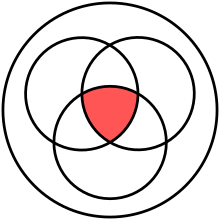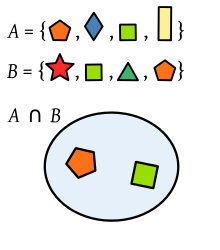 The intersection of two sets and represented by circles. is in red. | |
| Type | Set operation |
|---|---|
| Field | Set theory |
| Statement | The intersection of and is the set of elements that lie in both set and set . |
| Symbolic statement | |
In set theory, the intersection of two sets and denoted by [1] is the set containing all elements of that also belong to or equivalently, all elements of that also belong to [2]
YouTube Encyclopedic
-
1/5Views:1 976 720958 62736 115913 234973 095
-
Intersection of Sets, Union of Sets and Venn Diagrams
-
Intersection and union of sets | Probability and Statistics | Khan Academy
-
Set Theory: Types of Sets, Unions and Intersections
-
Sets: Union and Intersection
-
Sets: Union, Intersection, Complement
Transcription
Notation and terminology
Intersection is written using the symbol "" between the terms; that is, in infix notation. For example:
For an explanation of the symbols used in this article, refer to the table of mathematical symbols.
Definition



The intersection of two sets and denoted by ,[3] is the set of all objects that are members of both the sets and In symbols:
That is, is an element of the intersection if and only if is both an element of and an element of [3]
For example:
- The intersection of the sets {1, 2, 3} and {2, 3, 4} is {2, 3}.
- The number 9 is not in the intersection of the set of prime numbers {2, 3, 5, 7, 11, ...} and the set of odd numbers {1, 3, 5, 7, 9, 11, ...}, because 9 is not prime.
Intersecting and disjoint sets
We say that intersects (meets) if there exists some that is an element of both and in which case we also say that intersects (meets) at . Equivalently, intersects if their intersection is an inhabited set, meaning that there exists some such that
We say that and are disjoint if does not intersect In plain language, they have no elements in common. and are disjoint if their intersection is empty, denoted
For example, the sets and are disjoint, while the set of even numbers intersects the set of multiples of 3 at the multiples of 6.
Algebraic properties
Binary intersection is an associative operation; that is, for any sets and one has
Intersection distributes over union and union distributes over intersection. That is, for any sets and one has
Arbitrary intersections
The most general notion is the intersection of an arbitrary nonempty collection of sets. If is a nonempty set whose elements are themselves sets, then is an element of the intersection of if and only if for every element of is an element of In symbols:
The notation for this last concept can vary considerably. Set theorists will sometimes write "", while others will instead write "". The latter notation can be generalized to "", which refers to the intersection of the collection Here is a nonempty set, and is a set for every
In the case that the index set is the set of natural numbers, notation analogous to that of an infinite product may be seen:
When formatting is difficult, this can also be written "". This last example, an intersection of countably many sets, is actually very common; for an example, see the article on σ-algebras.
Nullary intersection

The conjunction of no argument is the tautology (compare: empty product); accordingly the intersection of no set is the universe.
In the previous section, we excluded the case where was the empty set (). The reason is as follows: The intersection of the collection is defined as the set (see set-builder notation)
However, when restricted to the context of subsets of a given fixed set , the notion of the intersection of an empty collection of subsets of is well-defined. In that case, if is empty, its intersection is . Since all vacuously satisfy the required condition, the intersection of the empty collection of subsets of is all of In formulas, This matches the intuition that as collections of subsets become smaller, their respective intersections become larger; in the extreme case, the empty collection has an intersection equal to the whole underlying set.
Also, in type theory is of a prescribed type so the intersection is understood to be of type (the type of sets whose elements are in ), and we can define to be the universal set of (the set whose elements are exactly all terms of type ).
See also
- Algebra of sets – Identities and relationships involving sets
- Cardinality – Definition of the number of elements in a set
- Complement – Set of the elements not in a given subset
- Intersection (Euclidean geometry) – Shape formed from points common to other shapes
- Intersection graph – Graph representing intersections between given sets
- Intersection theory – Branch of algebraic geometry
- List of set identities and relations – Equalities for combinations of sets
- Logical conjunction – Logical connective AND
- MinHash – Data mining technique
- Naive set theory – Informal set theories
- Symmetric difference – Elements in exactly one of two sets
- Union – Set of elements in any of some sets
References
- ^ "Intersection of Sets". web.mnstate.edu. Archived from the original on 2020-08-04. Retrieved 2020-09-04.
- ^ "Stats: Probability Rules". People.richland.edu. Retrieved 2012-05-08.
- ^ a b "Set Operations | Union | Intersection | Complement | Difference | Mutually Exclusive | Partitions | De Morgan's Law | Distributive Law | Cartesian Product". www.probabilitycourse.com. Retrieved 2020-09-04.
- ^ Megginson, Robert E. (1998). "Chapter 1". An introduction to Banach space theory. Graduate Texts in Mathematics. Vol. 183. New York: Springer-Verlag. pp. xx+596. ISBN 0-387-98431-3.
Further reading
- Devlin, K. J. (1993). The Joy of Sets: Fundamentals of Contemporary Set Theory (Second ed.). New York, NY: Springer-Verlag. ISBN 3-540-94094-4.
- Munkres, James R. (2000). "Set Theory and Logic". Topology (Second ed.). Upper Saddle River: Prentice Hall. ISBN 0-13-181629-2.
- Rosen, Kenneth (2007). "Basic Structures: Sets, Functions, Sequences, and Sums". Discrete Mathematics and Its Applications (Sixth ed.). Boston: McGraw-Hill. ISBN 978-0-07-322972-0.

























































